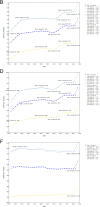Trends and inequalities in the global burden of alzheimer's disease and other dementias, 1990-2021: a Chinese perspective
- PMID: 40885984
- PMCID: PMC12398128
- DOI: 10.1186/s12889-025-24097-x
Trends and inequalities in the global burden of alzheimer's disease and other dementias, 1990-2021: a Chinese perspective
Abstract
Background: Given the growing global burden of Alzheimer's Disease and Other Dementias (ADODs) and inequalities in its distribution, it is of great necessity to analyze the trends and cross-country inequalities in the burden of ADODs globally and in China from 1990 to 2021.
Methods: Estimates and 95% uncertainty intervals (UIs) for incidence, prevalence, and disability-adjusted life years (DALYs) of ADODs were obtained from the Global Burden of Diseases Study (GBD) 2021. We described the epidemiology of ADODs at global, regional, and national levels, conducting temporal trend analyses using estimated annual percentage change, joinpoint regression, and age-period-cohort model. Additionally, we performed spatial autocorrelation, decomposition, and cross-country inequality analyses, comparing the burden in China to global trends.
Results: The global burden of ADODs increased overall from 1990 to 2021. GBD 2021 estimated 9,837,056 incident cases, 56,856,688 prevalent cases, and 36,332,687 DALYs for ADODs worldwide in 2021, with the highest case number in East Asia and highest age-standardized rate of DALYs in central sub-Saharan Africa. Spatial trends analyses showed hot spots in sub-Saharan Africa, the Middle East and North Africa, Europe, and High-income North America. Decomposition analysis revealed that changes in DALYs were primarily driven by population growth and aging, followed by prevalence, case fatality, and disease severity. Significant increases in absolute and relative sociodemographic index (SDI)-related inequalities in DALYs were observed from 1990 to 2021, with 318.19 to 759.97, and 0.43 to 0.49, respectively.
Conclusion: The burden of ADODs globally and in China showed overall increasing trends from 1990 to 2021. This increase was primarily driven by population growth and aging. Countries with high SDI values faced a disproportionately large burden of dementia, and SDI-related inequalities among countries exacerbated over time. These findings highlight significant challenges for the prevention and control of ADODs globally and in China.
Keywords: China-specific epidemiology; Dementia epidemiology; Global burden; Health inequalities; Sociodemographic index.
© 2025. The Author(s).
Conflict of interest statement
Declarations. Ethics approval and consent to participate: No ethical approval was required for the use of deidentified and secondary data in the GBD study. Consent for publication: All authors consent to the publication of this research. Competing interests: The authors declare no competing interests.
Figures





Similar articles
-
Mapping the global burden of early-onset Parkinson's disease: socioeconomic and regional inequalities from the Global Burden of Disease Study 2021.Front Public Health. 2025 Jul 22;13:1618533. doi: 10.3389/fpubh.2025.1618533. eCollection 2025. Front Public Health. 2025. PMID: 40766033 Free PMC article.
-
Global pattern, trend and cross-country inequalities of inguinal, femoral, and abdominal hernia among individuals aged 60 and above from 1990 to 2021 and projections until 2040: a population-based study.Surg Endosc. 2025 Jul;39(7):4335-4344. doi: 10.1007/s00464-025-11810-5. Epub 2025 May 28. Surg Endosc. 2025. PMID: 40437076
-
Trends, inequalities, and cross-location similarities in global dementia burden and attributable risk factors across 204 countries and territories: a systematic analysis for the Global Burden of Disease Study 2021.Int J Surg. 2025 Aug 1;111(8):5298-5310. doi: 10.1097/JS9.0000000000002628. Epub 2025 Jun 20. Int J Surg. 2025. PMID: 40540265
-
Trend analysis and future predictions of global burden of alzheimer's disease and other dementias: a study based on the global burden of disease database from 1990 to 2021.BMC Med. 2025 Jul 1;23(1):378. doi: 10.1186/s12916-025-04169-w. BMC Med. 2025. PMID: 40597083 Free PMC article.
-
Temporal changes in the burden of type 2 diabetes mellitus across the BRICS, 1990-2021: a comprehensive analysis for the global burden of disease study 2021.BMC Public Health. 2025 Aug 30;25(1):2982. doi: 10.1186/s12889-025-23786-x. BMC Public Health. 2025. PMID: 40885896 Free PMC article.
References
-
- World Health Organization. International Statistical Classification of Diseases and Related Health Problems, 10th Revision (ICD-10). 2019. https://icd.who.int/browse10/2019/en (accessed Sep 24, 2024).
-
- Nandi A, Counts N, Chen S, Seligman B, Tortorice D, Vigo D, et al. Global and regional projections of the economic burden of Alzheimer’s disease and related dementias from 2019 to 2050: a value of statistical life approach. EClinicalMedicine. 2022;51: 101580. 10.1016/j.eclinm.2022.101580. - PMC - PubMed
MeSH terms
Grants and funding
LinkOut - more resources
Full Text Sources
Medical

